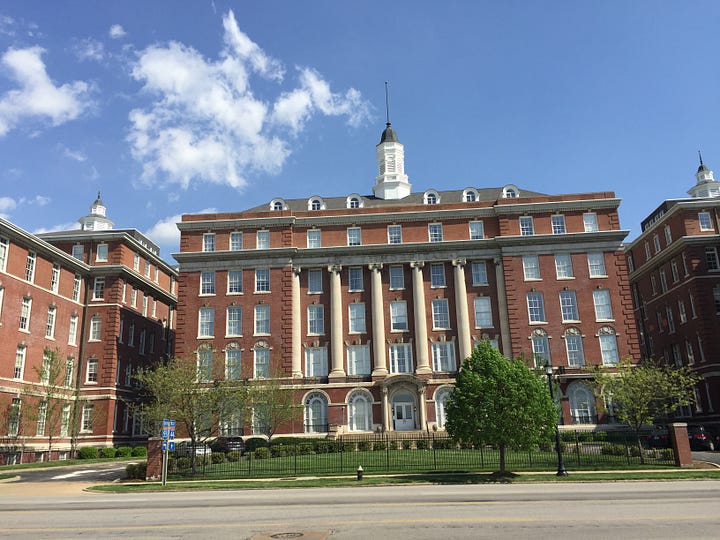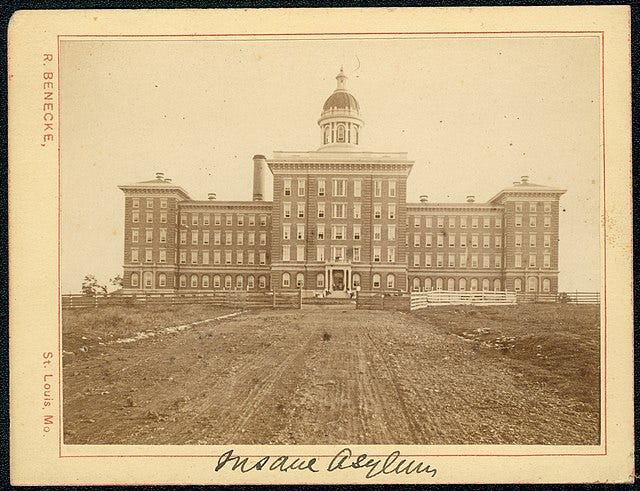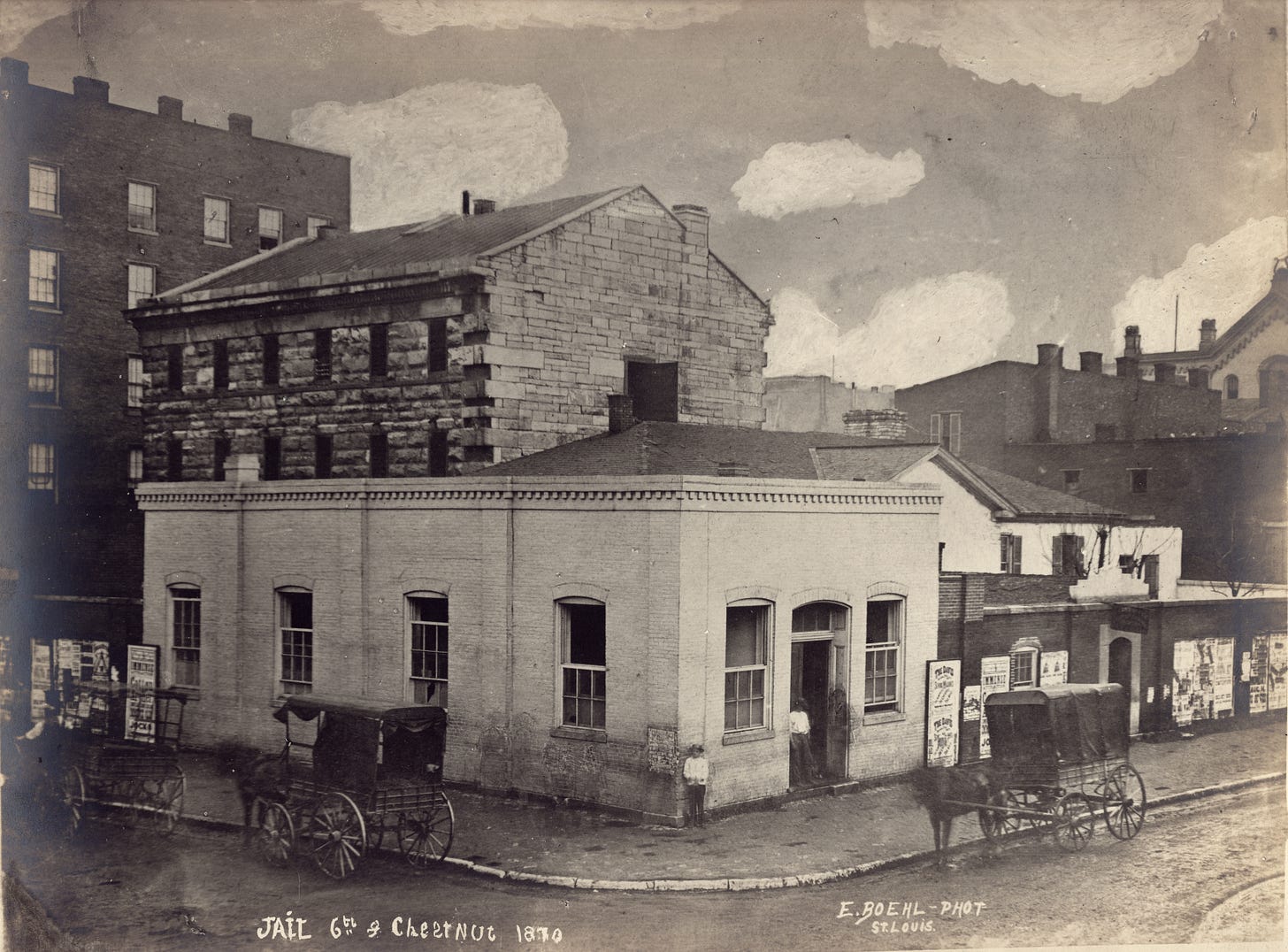If you would like to start from the beginning, the series starts here: In the Beginning: Part 1 The Buckfoot Gang
The synchronicity of the passing funeral cortège of a murdered young woman and Priscilla Boatright being called to the witness stand certainly wasn’t planned, but could not help but be noted. Her physical appearance is not described in as much detail as when she was in the audience at the Woodson trial, but it was mentioned that Mrs. Boatright remained clad in mourning clothes for her son Oscar who died sixteen months before, in November of 1874, as a result of his injuries.
Questions put to her were brief and intended to establish her perspective of her son rather than provide vivid details. Both attorneys deferred to her position as the mother of a murdered child and of one now on trial for murder; they were gentle with her.
Her testimony consisted of saying Robert was 17 at his last birthday, he was in good mental and physical health prior to his bout with typhoid which lasted 5-6 weeks, he had been “out of his mind” during the illness, his recovery was very slow, and his mental state was poor afterward. She testified he had tried to take his life twice, both times by hanging himself in his bedroom, but was discovered before he could do so. Both attempts were made over the span of only a couple of days. When Priscilla was asked if she had any idea why Robert would have attempted suicide, she said she didn’t know other than the family’s fear of him doing so had been discussed and he may have overheard it. She denied being aware of any cases of insanity in her family.
Once Priscilla descended the stand in the respectably hushed courtroom, the conveyor belt of defense witnesses continued. Depositions by witnesses who could not be present were read out. Two of which were from William H. Hicks, a bookkeeper who once boarded with the Boatright family but had moved to Selma, Alabama, and Bennett M. Brown, a printer who had lived next door to the family and had since relocated to Montgomery, Alabama. Both reiterated the same information given by prior witnesses testifying to Robert’s confusion, absent stares, and odd behavior.
The defense also brought in Mathias Schulter, a jailer who observed “strange conduct” by Robert while he was incarcerated. He said the prisoner would read and laugh (to be fair, I do that) and sometimes would groan (I might do that too, depending on the kind of day I’ve had). Mr. Schulter added that when a wall in the jail was being repaired, Robert had “torn down part of his cell.” This surely referred to the furnishings, such as they would have been, rather than the actual structure. A physician was called in who “prescribed” for him, but what he prescribed was not specified.
After a recess, the attorney Seymour Voullaire was sworn in. Mr. Voullaire had served as the state’s attorney for the prosecution during the Woodson trial and was present when the murder happened. He recounted what he saw that day.
The first of two medical experts was sworn in. Dr. Louis Bauer, Member of the Royal College of Surgeons, stated he had been educated in Berlin and other large European cities. He was appointed by the Prussian Government as a medical consultant to the judiciary there. He had experience testifying in around 30-40 trials and was the author of a number of medical works. Per the St. Louis Washington University timeline, Dr. Bauer became the head of Humboldt Medical College there in 1859. Neither this building nor City Hospital as it was in 1861 exists. A replacement building completed in 1905 still stands on the original site and is now luxury condominiums.


Dr. Bauer presented a lengthy hypothetical case study of a patient using all the purported facts of Robert P. Boatright’s case. His summation was that, if all information was accurate, he had no reservation declaring that person insane at the time of the crime. He made the point of saying epilepsy was a nervous system disease but stopped short of specifying if it could have caused the type of insanity the defense described. His opinion was that typhoid fever could affect the patient’s brain “more or less,” depending on the person’s constitution, length of illness, etc.
Attorney Normile cross-examined Dr. Bauer, asking him for his definition of insanity. Dr. Bauer replied, it is “that state of mind in which there was an aberration of thought, and the feelings did not correspond with the feelings of people in general.” Attorney Normile asked if Dr. Bauer would accept the meaning of insanity as defined by the Prussian physician, Dr. Geisel as, “Insanity is a derangement of the mental faculties which deprives the man of the power of thinking and acting as regards his happiness, preservation and responsibility.” Dr. Bauer concurred with this definition.
The second medical expert was the wonderfully named Dr. William B. Hazard. He stated he had been practicing medicine since March of 1866 (for 10 years) with special attention to mental and nervous diseases. He had been Assistant Physician at Kings County Hospital in New York, Resident Physician at the St. Louis County Insane Asylum, and Consulting Physician at City Hospital.
Dr. Hazard had listened to Dr. Bauer’s case study and agreed with him that such a person would have been insane at the time of the “alleged homicide.” He said he knew a single attack of epilepsy could be sufficient to change the moral character of a man and that persons suffering from epilepsy should not be held accountable for their conduct.
During cross-examination by Atty. Normile, Dr. Hazard made the statement that he believed physicians were the only thoroughly qualified persons to judge insanity to which Normile replied, “My profession will have something to say about that,” and then made reference to historical figures thought to be insane: Napoleon, Martin Luther, and King George III, as well as reference to the trial of Anton Holm who was acquitted on grounds of insanity but three days after release showed no sign of insanity.
I’m no legal expert, and I understand the point Normile was trying to make, but I think the claim for this particular defense is that a defendant is considered insane at the time of the crime but not necessarily after the crime. So, by reason of temporary insanity rather than ongoing and/or permanent insanity.
With this, Francis Turner rested the case for the defense. The floor was shifted to Prosecutor Normile to call rebuttal witnesses. The only new information during rebuttal was unusual testimony from James Tracy, a former detective who had been demoted to patrolman sometime since the year before. Tracy swore to seeing Robert at the police office in Four Courts where personally asked him, “Why did you cut that boy?” He said Robert replied, “He killed my brother and I killed him.” Tracy said he told the boy it was a cowardly act, to which he’d replied that he’d promised his dying brother he would kill the boy and added, “I don’t give a damn for a man who wouldn’t keep his word.” Tracy said this exchange happened with no appearance of insanity whatsoever from the defendant. He felt the boy embodied “concentrated rage” and knew full well what he was about.
Patrolman Tracy was asked by Attorney Turner, “Are you not an enemy Mr. Boatright?” (the defendant’s father). And also asked Tracy was he not rumored to be a member of the “Harrigan & O’Connor ring” within the police, to which Tracy replied he knew nothing about any “rings in the police.” Lawrence Harrigan was Chief of Police at the time. Daniel O’Connor had been Tracy’s superior and was released from the police force. When asked, Tracy claimed he had no idea why he had been demoted and denied knowledge in response to all questions put to him after that. He was then dismissed.
In response, Deputy James Sullivan was called to the stand. He had been the arresting officer who escorted the defendant from the courthouse on the day of the murder and was present during questioning at Four Courts. He said he did not see Detective Tracy in any location in the courthouse or Four Courts that day. He never heard Robert tell anyone he had promised his brother he would kill Charles Woodson as Tracy had said. NB: Deputy Sullivan was referring to the time following Robert’s containment. Witnesses in the courtroom claim to have heard him say this at the moment of the attack.
Police Chief Harrigan was called for as the next witness, but there was no response. It isn’t clear if Harrigan was in the courtroom or was supposed to be and wasn’t, but the article states after several minutes of waiting, Attorney Normile declared all witness testimony completed.
Photo below is the old City Jail. This is most likely where Robert was kept from the time of the murder (March 1875), rather than in any temporary cells in the basement of the courthouse where he was taken immediately after the murder. This jail was catty-corner to the courthouse at the time.
Following a recess, the defense spent the afternoon giving their closing statement, presented first by Francis Turner then his partner Joseph Harris. Turner discussed each point by which he wanted the jury to understand insanity had been proven. Attorney Harris spoke of the importance placed upon the jurors in making their decision and the consequences of making any errors. He did revisit some of his client’s weird behavior before once again emphasizing the gravity of what is asked of a jury.
The court adjourned for the day in anticipation of the prosecution’s closing statements the following morning, after which the case would be given to the jury for deliberation.








